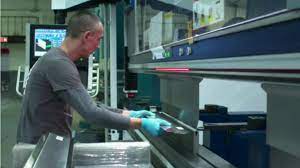Casting machine operator
SECTOR: GEMS & JEWELLERY
SUB-SECTOR: Cast and Diamonds-Set Jewellery
OCCUPATION: Casting
REFERENCE ID: G&J/Q2801
ALIGNED TO: NCO-2004/ NIL
Casting Machine Operator: A Casting Machine Operator is also known as ‘Caster’
in the Indian jewellery making industry. In the cast and diamond-set jewellery
manufacturing, investment casting is among the most critical job roles.
Brief Job Description: The individual at work converts wax models to jewellery
pieces through investment casting process. The individual invests the flask and
then operates semi to fully-automated machines to pour and regulate the flow of
molten precious metal into cavities created by melted wax, to produce cast
jewellery pieces on mass scale.
Personal Attributes: The job requires the individual to have: attention to details,
physical strength to handle heavy equipment, ability to multi-task in a process
driven team and work in a high temperature environment for long hours. A caster
is expected to have integrity in dealing with high value jewellery.
Operate the casting machine
Unit Code G&J/N2801
Unit Title
(Task) Operate the casting machine
Description This OS unit is about making investment flask, implement burnout cycle, calculate
and weigh the correct amount of alloy, melt and cast the alloy into jewellery pieces
Scope This unit/task covers the following:
Collect wax tree and alloys from supervisor and consumables from stores
collect wax trees and inspect for any imperfections in the wax tree such as
loosely soldered wax pieces on central stem
plan the casting cycle in consultation with production manager
calculate and weigh the required amount of alloy (precious metal) required as
per wax tree and job sheet
Melt the alloys
add the alloys in a melting machine
set the temperature as per machine specifications mentioned for the alloy
stir the molten alloy and remove after specified time
solidify and cool the alloy in water
collect carbon particles and dust separately
Invest a flask
prepare slurry from specified amount of Plaster of Paris (PoP), boric acid and
demineralised (DM) water
Place the wax tree in the flask
Pour the slurry over wax tree in the flask and leave it for drying at room
temperature as per operating procedure
remove the rubber base from the bottom of flask and prepare the flask for
burnout cycle
Execute burnout cycle on flask to melt wax tree
set the furnace cycle as per industry specifications
place the flask in the furnace for 12-16 hours, depending on the furnace
temperature specifications
set the temperature and time of furnace according to its operating parameters
bring out the flask and leave it at room temperature for cooling
Melt and cast the precious metal alloy
set casting machine parameters as per machine’s operating specifications such
as temperature and duration of casting
place the flask out from burnout cycle, in the casting machine
add precious metal alloy in the crucible of casting machine
pour the metal alloy – for manual operations or wait for metal alloy to be
poured automatically – once the required temperature is reached
remove the flask and leave it for cooling at the room temperature
Operate the casting machine
Clean the precious metal tree
Clean the flask under high pressure water spray to remove PoP from precious
metal tree
Dry precious metal tree with blotting paper
Control gold loss
collect gold from melting and casting machine
tally account as per specified standards
conduct regular and controlled environment cleaning for collection
maintain the proportion of re-use of gold and new as per company standards
Detect product defects
identify design manufacturability in terms of flow of metal in casting machine
inform supervisor if product has casting defects such as porosity, blisters,
bubbles, cracks, etc.
understand the type of defect, assess if filing and polishing unit can rectify the
defect or rework or design change is required
Quality check
melt and recast product returned from QC
check weight as per design
Report problems related to:
problems with machines and equipment
shortage of consumables and metal alloys
reasons for anticipated delays that may adversely affect delivery
Performance Criteria(PC) w.r.t. the Scope
Element Performance Criteria
Melting the alloys To be competent, the user/individual on the job must be able to:
PC1. accurately compute alloy required as per wax tree weight
PC2. proportionately use re-cycled and new gold in the alloy making
PC3. ensure minimal accidents while handling molten metal
Investment To be competent, the user/individual on the job must be able to:
PC4. mix of all the required materials such as PoP, boric acid and DM water for
investment process as per industry standards
PC5. prepare bubble-free investment of flask
Running burnout cycle To be competent, the user/individual on the job must be able to:
PC6. constantly monitor furnace temperature for complete burnout cycle
duration so that an incomplete process does not lead to casting defects
Casting To be competent, the user/individual on the job must be able to:
PC7. set machine parameters as per machine specifications prescribed for a
particular alloy
Operate the casting machine
PC8. Pour metal at the right temperature in manual pouring mode
Productivity To be competent, the user/individual on the job must be able to:
PC9. properly plan casting cycles for the optimum utilisation of machines
PC10. minimise rework and precious metal loss in the casting process
PC11. timely deliver casted jewellery pieces to next process
PC12. Produce number of casted jewellery pieces or precious metal tree as per
target deliverable and quality approved by the supervisor
Quality of output To be competent, the user/individual on the job must be able to:
PC13. produce defect-free casted jewellery pieces
PC14. ensure minimum damage to the set stones during casting process
PC15. produce Quality Control okayed cast jewellery piece
Resolving problems To be competent, the user/individual on the job must be able to:
PC16. deliver casted jewellery pieces on time by reporting problems faced or
anticipated well in advance
Knowledge and Understanding (K)
A. Organizational
Context
The user/individual on the job needs to know and understand:
KA1. company’s policies on: acceptable limits of gold and other precious metal
loss, quality, incentives, delivery standards, safety and hazards, integrity
and IPR, personnel management and dress code
KA2. importance of the individual’s role in the workflow
KA3. reporting structure
B. Technical
Knowledge
The user/individual on the job needs to know and understand:
KB1. metallurgy (gold alloy properties including malleability)
KB2. methods of calculating required quantities of alloys
KB3. production process planning
KB4. uses of different types of tools, consumables and machines in jewellery
casting process
KB5. potential work hazards while handling molten metal
Skills (S) [Optional]
A. Core Skills/ Generic
Skills
Basic reading and writing skills
The user/ individual on the job needs to know and understand how to:
SA1. read notes, designs and instructions on job sheet
SA2. read company rules and compliance documents required to complete the
work
Calculation skills
The user/individual on the job needs to know and understand how to:
SA3. calculate and weigh the correct amount of alloy required as per wax tree
and job sheet
SA4. assess gold loss during the casting process so as to deliver jewellery pieces
of required weight
Operate the casting machine
Teamwork and multitasking
The user/individual on the job needs to know and understand how to:
SA5. share work load as required
SA6. receive feedback from co-workers and supervisor
SA7. share knowledge with co-workers and supervisor
B. Professional Skills Reading design
The user/individual on the job needs to know and understand:
SB1. the steps involved in casting jewellery as per design
Use of tools and machines
The user/individual on the job needs to know and understand how to:
SB2. use of following key tools, machines and consumables for casting process:
Investment flasks
Measuring cylinder
Carbon stirring rod
Plaster of Paris (PoP)
PoP particulate filters
Slurry mixing equipment
Metal Melter
Casting machine
Kilns
Burnout ovens/furnace
Water jet spray
gripper
SB3. work in a safe environment, i.e., without injuries
SB4. organise tools and documents required for the job
Decision making
The user/individual on the job needs to know and understand how to:
SB5. plan the casting batches for optimum utilisation of the casting machine
Reflective thinking
The user/individual on the job needs to know and understand how to:
SB6. give design inputs, for example, the number and size of sprue added to
master model, for required flow of molten metal
SB7. improve work processes
SB8. reduce precious metal loss
SB9. effectively use the casting processes to improve the quality and
productivity of the jewellery piece
Critical thinking
The user/individual on the job needs to know and understand how to:
SB10. anticipate process disruption and reasons for delay
Respect and maintain IPR
Unit Code G&J/N9901
Unit Title
(Task) Maintain IPR of company and respect IPR of other companies
Description This OS unit is about protecting company’s IPR and avoiding infringement to IPR of
other companies
Scope This unit/task covers the following:
Protect company’s Intellectual Property Rights (IPR)
prevent leak of new designs to competitors by reporting on time
be aware of any of company’s product or design patents
report IPR violations observed in the market, to supervisor or company heads
Avoid infringement to IPR of other companies
read copyright clause of the material published on the internet and any other
printed material
consult supervisor or senior management when in doubt about using publicly
available information
report any infringement observed in the company
Performance Criteria(PC) w.r.t. the Scope
Element Performance Criteria
Respecting and
Maintaining IPR
To be competent, the user/individual on the job must:
PC1. be able to spot plagiarism and report
PC2. be aware of patents and IPR
PC3. not be involved in IPR violations
Knowledge and Understanding (K)
A. Organizational
Context
The user/individual on the job needs to know and understand:
KA1. company’s policies on IPR and plagiarism
KA2. reporting structure
KA3. company’s unique product range
B. Technical
Knowledge
The user/individual on the job needs to know and understand:
KB1. patents and IPR laws
KB2. how IPR protection is important for competitiveness of a company
Skills (S) [Optional]
A. Core Skills/
Generic Skills
Communication skills
The user/ individual on the job needs to know and understand how to:
SA1. effectively communicate any observed IPR violations or order leaks
B. Professional Skills Decision making
The user/individual on the job needs to know and understand how to:
SA2. report potential sources of violations
Reflective thinking
The user/individual on the job needs to know and understand to:
SA3. learn from past mistakes and report IPR violations on time
Critical thinking
The user/individual on the job needs to know and understand how to:
SA4. spot signs of violations and alert authorities in time
Coordinate with others
Unit Code G&J/N9902
Unit Title
(Task) Interact with colleagues and seniors
Description This OS unit is about communicating with colleagues and seniors in order to achieve
smooth and hazard-free work flow
Scope This unit/task covers the following:
Interact with supervisor
receive work instructions and raw materials from reporting supervisor
communicate to reporting supervisor about process-flow improvements, product
defects received from previous process, repairs and maintenance of tools and
machinery as required
communicate any potential hazards or expected process disruptions
handover completed work to supervisor
Interact with colleagues within and outside the department
work as a team with colleagues and share work as per their or own work load and
skills
work with colleagues of other departments
communicate and discuss work flow related difficulties in order to find solutions
with mutual agreement
receive feedback from qc and rework in order to complete work on time
Performance Criteria(PC) w.r.t. the Scope
Element Performance Criteria
Interaction with
supervisor
To be competent, the user/individual on the job must be able to:
PC1. understand the work output requirements
PC2. comply with company policy and rule
PC3. deliver quality work on time as required by reporting any anticipated reasons
for delays
Interactions with
colleagues and other
departments
To be competent, the user/individual on the job must be able to:
PC4. put team over individual goals
PC5. be able to resolve conflicts
PC6. learn how to multi-task relevant activities
Knowledge and Understanding (K)
A. Organizational
Context
The user/individual on the job needs to know and understand:
KA1. company’s policies on: preferred language of communication, reporting and
escalation policy, quality delivery standards, and personnel management
KA2. reporting structure
B. Technical
Knowledge
The user/individual on the job needs to know and understand how to:
KB1. communicate effectively
KB2. build team coordination
Skills (S) [Optional]
A. Core Skills/
Generic Skills
Communication skills
The individual on the job needs to know and understand how to:
SA1. read and write preferred language of communication as prescribed by the
company
SA2. read job sheets and interpret technical details mentioned in the job sheet
B. Professional Skills Decision making
The individual on the job needs to know and understand:
SB1. how to spot and communicate potential areas of disruptions to work process
and report the same
SB2. when to report to supervisor and when to deal with a colleague individually,
depending on the type of concern
Reflective thinking
The individual on the job needs to know and understand how to:
SB3. improve work processes by interacting with others and adopting best
practices
Critical thinking
The individual on the job needs know and understand how to:
SB4. spot process disruptions and delays and report and communicate with
solutions
Maintain occupational health and safet
Unit Code G&J/N9905
Unit Title
(Task) Maintain occupational health and safety
Description This OS unit is about being aware of, communicating and taking steps towards
minimizing potential hazards and dangers of accidents on the job and maintaining
occupational health and safety
Scope This unit/task covers the following:
Understand potential sources of accidents
to avoid accidents related to use of potentially dangerous chemicals, sharp tools
and machines
Use safety gear to avoid accidents
wear safety gear such as goggles, mask, gloves, ear plugs
Actively participate in the health and safety awareness campaigns
attend fire drills organised by the company or industrial zone
learn first aid procedure
be alert about designated assembly area in the event of an emergency
read and understand the evacuation and emergency procedures
Communicate to reporting supervisor about:
process flow improvements that can reduce anticipated or repetitive hazards
mishandling of tools, machines or hazardous materials
electrical problems that could result in accident
Performance Criteria(PC) w.r.t. the Scope
Element Performance Criteria
Communicating
potential accident
points
To be competent, the user/individual on the job must be able to:
PC1. spot and report potential hazards on time
PC2. follow company policy and rules regarding use of hazardous materials
PC3. attend and actively participate in the health and safety campaigns organised
by the company
Using safety gear To be competent, the user/individual on the job must be able to:
PC4. use or wear safety gear as per the rules of the company
Knowledge and Understanding (K)
A. Organizational
Context
The user/individual on the job needs to know and understand:
KA1. company’s policies on: safety and hazards and personnel management
KA2. reporting structure
B. Technical
Knowledge
The user/individual on the job needs to know and understand:
KB1. how different chemicals react and what could be the danger from them
KB2. how to use machines and tools without suffering bodily harm
Skills (S) [Optional]
A. Core Skills/
Generic Skills
Communication skills
The individual on the job needs to know and understand how to:
SA1. effectively communicate the danger
Organising skills
The individual on the job needs to know and understand how to:
SA2. keep all the tools in an organised manner so as to avoid accidents
SA3. keep the work environment safe and clean
B. Professional Skills Decision making
The individual on the job needs to know and understand how to:
SB1. report potential sources of danger
SB2. follow prescribed procedure in the event of an accident
SB3. wear appropriate safety gear to avoid an accident
Reflective thinking
The individual on the job needs to know and understand to:
SB4. learn from past mistakes regarding use of hazardous machines or chemicals
Critical thinking
The individual on the job needs to know and understand how to:
SB5. spot danger
Decision making
The individual on the job needs to know and understand how to:
SB6. report potential sources of danger
SB7. follow prescribed procedure in the event of an accident
SB8. wear appropriate safety gear to avoid an accident
Keywords /Terms Description
Sector Sector is a conglomeration of different business operations having similar
business and interests. It may also be defined as a distinct subset of the
economy whose components share similar characteristics and interests.
Sub-sector Sub-sector is derived from a further breakdown based on the
characteristics and interests of its components.
Occupation Occupation is a set of job roles, which perform similar/ related set of
functions in an industry.
Function Function is an activity necessary for achieving the key purpose of the
sector, occupation, or an area of work, which can be carried out by a
person or a group of persons. Functions are identified through functional
analysis and form the basis of OS.
Sub-function Sub-functions are sub-activities essential to fulfil the achieving the
objectives of the function.
Job role Job role defines a unique set of functions that together form a unique
employment opportunity in an organisation.
Occupational Standards
(OS)
OS specify the standards of performance an individual must achieve
when carrying out a function in the workplace, together with the
knowledge and understanding they need to meet that standard
consistently. Occupational Standards are applicable both in the Indian
and global contexts.
Performance Criteria Performance criteria are statements that together specify the standard of
performance required when carrying out a task.
National Occupational
Standards (OS)
NOS are occupational standards which apply uniquely in the Indian
context.
Qualifications Pack (QP) QP comprises the set of OS, together with the educational, training and
other criteria required to perform a job role. A QP is assigned a unique
qualifications pack code.
Unit Code Unit code is a unique identifier for an Occupational Standard, which is
denoted by an ‘N’
Unit Title Unit title gives a clear overall statement about what the incumbent
should be able to do.
Description Description gives a short summary of the unit content. This would be
helpful to anyone searching on a database to verify that this is the
appropriate OS they are looking for.
Scope Scope is a set of statements specifying the range of variables that an
individual may have to deal with in carrying out the function which have
a critical impact on quality of performance required.
Knowledge and
Understanding
Knowledge and understanding are statements which together specify the
technical, generic, professional and organisational specific knowledge
that an individual needs in order to perform to the required standard.
Organisational Context Organisational context includes the way the organisation is structured
and how it operates, including the extent of operative knowledge
managers have of their relevant areas of responsibility.
Technical Knowledge Technical knowledge is the specific knowledge needed to accomplish
specific designated responsibilities.
Core Skills/ Generic
Skills
Core skills or generic skills are a group of skills that are the key to learning
and working in today’s world. These skills are typically needed in any
work environment in today’s world. These skills are typically needed in
any work environment. In the context of the OS, these include
communication related skills that are applicable to most job roles.
Keywords /Terms Description
CAD Computer Aided Design
CAM Computer Aided Manufacturing
IPR Intellectual Property Rights
NOS National Occupational Standard(s)
NVQF National Vocational Qualifications Framework
NSQF National Qualifications Framework
NVEQF National Vocational Education Qualifications Framework
QP Qualifications Pack
CRITERIA FOR ASSESSMENT OF TRAINEES
Job Role Casting Machine Operator
Qualification Pack G&J/Q2801
Sector Skill Council Gem & Jewellery
Guidelines for Assessment
- Criteria for assessment for each Qualification Pack will be created by the Sector Skill Council. Each
Performance Criteria (PC) will be assigned marks proportional to its importance in NOS. SSC will also lay
down proportion of marks for Theory and Skills Practical for each PC. - The assessment for the theory part will be based on knowledge bank of questions created by the SSC.
- Individual assessment agencies will create theory question papers for candidates at every
examination/training centre. (as per assessment criteria below) - Individual assessment agencies will create practical tests for skill evaluation for candidates at every
examination/training centre. (as per assessment criteria below) - To pass the Qualification Pack, every candidate should score a minimum of 50% in theory and 70% in
practical to successfully clear the assessment. - In case of successfully passing only certain number of NOS’s, the candidate is eligible to take subsequent
assessment on the balance NOS’s to pass the Qualification Pack









